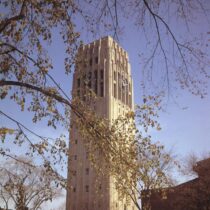Magazine

The Carillon and the Egyptologist
The carillon bells in Burton Memorial Tower on U-M’s campus are played or their original keyboard thanks to an unlikely savior: a U-M Egyptologist.
by Madeleine Bradford
Early in his career as a U-M professor of dentistry, Dr. James E. Harris loved the music of the Burton Tower bells on Central Campus.
He remembered that music, even as his U-M work took him across the world, to the Cairo Museum in Egypt. There, in a joint 1967 project between U-M and Alexandria University, Harris examined the X-rayed teeth of mummified Egyptian royalty and used dental records to gain medical insights about them—all without having to unwrap the bodies.
Harris developed an expertise in Egyptology, which soon became his career.
Harris is listed as part of the U-M team that, in 1976, identified King Tut’s grandmother, Queen Tiye, using X-rays and hair analysis. Previously known only as an “Elder Lady,” Queen Tiye’s mummy was reconnected to her name, and moved to the Cairo Museum.
Meanwhile, the years were taking their toll on the bell tower, and the building needed renovations and repairs. The older bells were replaced in 1974, and the carillon keyboard was almost scrapped. It was removed to a warehouse of the Verdin Company, a carillon-making business where, by chance, Harris discovered it.
As a staunch supporter of the University of Michigan’s carillon music, he purchased the keyboard and held onto it for decades.
Then, serendipity struck.
In 2011, new renovations on Burton Tower began, with plans to reinstall the two highest octaves of old bells. Assistant Professor Steven Ball, a carillon music expert, had saved the original bells from destruction, and set about tracking down the keyboard, too.
He discovered that it was owned by Harris, who leapt at the chance to get it back where it belonged. What could be better than playing the original bells on their own keyboard? Harris donated the keyboard back to the University of Michigan, along with funding to restore it to its original state.
Today, U-M students can take classes to learn to play the carillon keyboard, which is a complex, physically demanding mix of pushing wooden levers and striking hammers. The public is welcome to attend 30-minute recitals at the top of the tower, which are performed at noon every weekday that classes are in session. The concerts are followed by a visitor Q&A session.
More about the Burton Memorial Tower can be found in the Bentley’s Building and Grounds Department records, and more about the Baird Carillon can be found in the Bentley’s School of Music, Theatre, and Dance records. Additional details about Dr. James Harris can be found in his faculty file, located in the News and Information Faculty and Staff Files collection.
